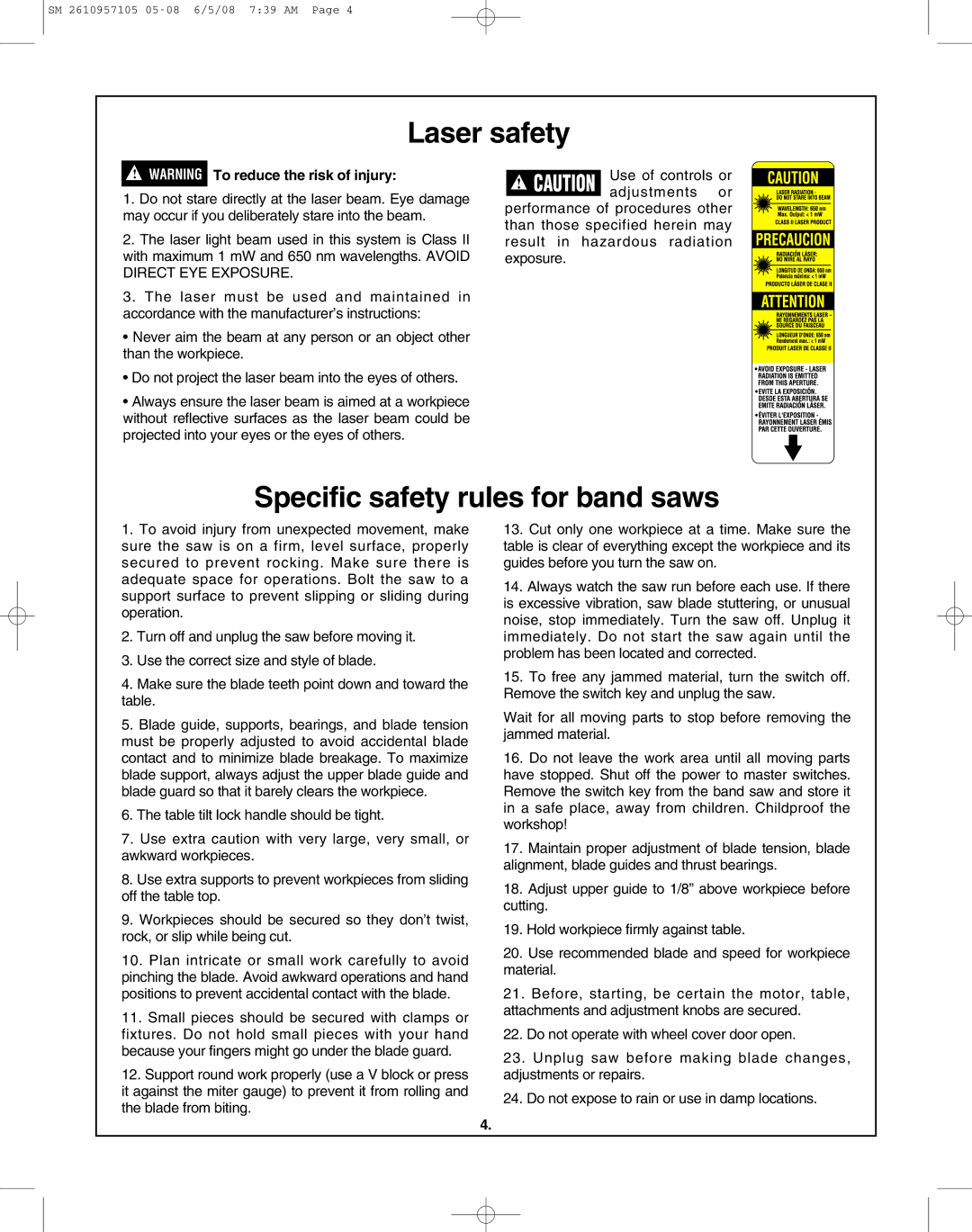
SM 2610957105
Laser safety
!WARNING To reduce the risk of injury:
1.Do not stare directly at the laser beam. Eye damage may occur if you deliberately stare into the beam.
2.The laser light beam used in this system is Class II with maximum 1 mW and 650 nm wavelengths. AVOID DIRECT EYE EXPOSURE.
3.The laser must be used and maintained in accordance with the manufacturer’s instructions:
•Never aim the beam at any person or an object other than the workpiece.
•Do not project the laser beam into the eyes of others.
•Always ensure the laser beam is aimed at a workpiece without reflective surfaces as the laser beam could be projected into your eyes or the eyes of others.
Use of controls or ! CAUTION adjustments or
performance of procedures other than those specified herein may result in hazardous radiation exposure.
Specific safety rules for band saws
1.To avoid injury from unexpected movement, make sure the saw is on a firm, level surface, properly secured to prevent rocking. Make sure there is adequate space for operations. Bolt the saw to a support surface to prevent slipping or sliding during operation.
2.Turn off and unplug the saw before moving it.
3.Use the correct size and style of blade.
4.Make sure the blade teeth point down and toward the table.
5.Blade guide, supports, bearings, and blade tension must be properly adjusted to avoid accidental blade contact and to minimize blade breakage. To maximize blade support, always adjust the upper blade guide and blade guard so that it barely clears the workpiece.
6.The table tilt lock handle should be tight.
7.Use extra caution with very large, very small, or awkward workpieces.
8.Use extra supports to prevent workpieces from sliding off the table top.
9.Workpieces should be secured so they don’t twist, rock, or slip while being cut.
10.Plan intricate or small work carefully to avoid pinching the blade. Avoid awkward operations and hand positions to prevent accidental contact with the blade.
11.Small pieces should be secured with clamps or fixtures. Do not hold small pieces with your hand because your fingers might go under the blade guard.
12.Support round work properly (use a V block or press it against the miter gauge) to prevent it from rolling and the blade from biting.
4.
13.Cut only one workpiece at a time. Make sure the table is clear of everything except the workpiece and its guides before you turn the saw on.
14.Always watch the saw run before each use. If there is excessive vibration, saw blade stuttering, or unusual noise, stop immediately. Turn the saw off. Unplug it immediately. Do not start the saw again until the problem has been located and corrected.
15.To free any jammed material, turn the switch off. Remove the switch key and unplug the saw.
Wait for all moving parts to stop before removing the jammed material.
16.Do not leave the work area until all moving parts have stopped. Shut off the power to master switches. Remove the switch key from the band saw and store it in a safe place, away from children. Childproof the workshop!
17.Maintain proper adjustment of blade tension, blade alignment, blade guides and thrust bearings.
18.Adjust upper guide to 1/8” above workpiece before cutting.
19.Hold workpiece firmly against table.
20.Use recommended blade and speed for workpiece material.
21.Before, starting, be certain the motor, table, attachments and adjustment knobs are secured.
22.Do not operate with wheel cover door open.
23.Unplug saw before making blade changes, adjustments or repairs.
24.Do not expose to rain or use in damp locations.
